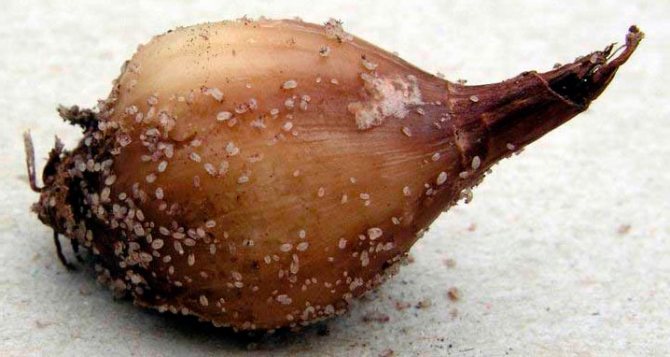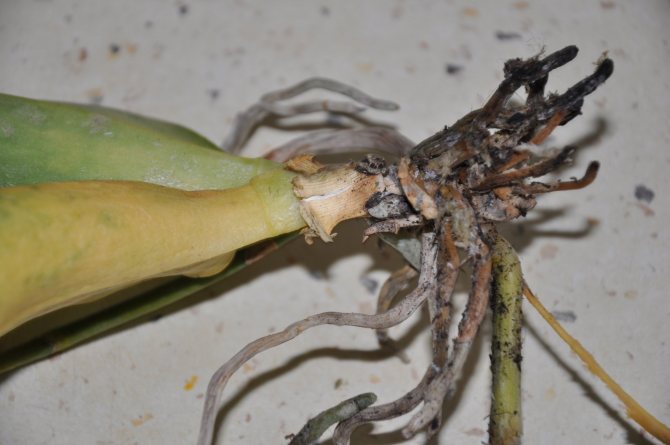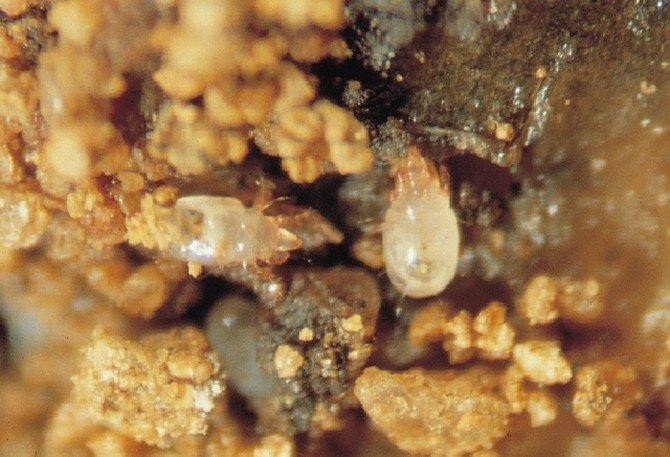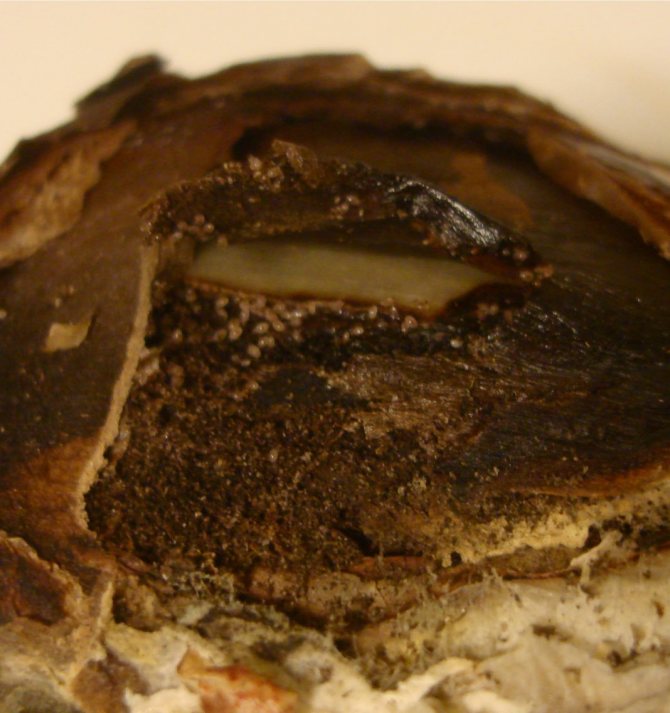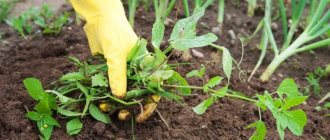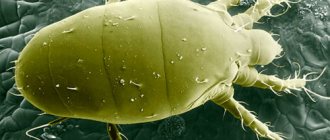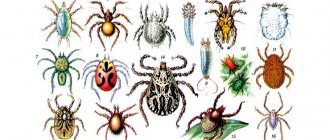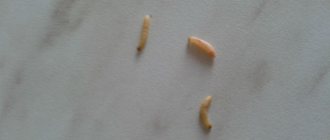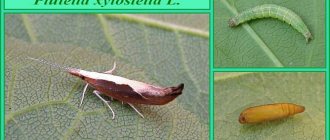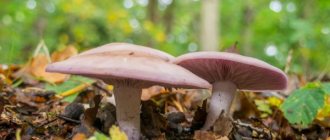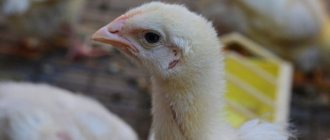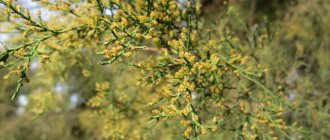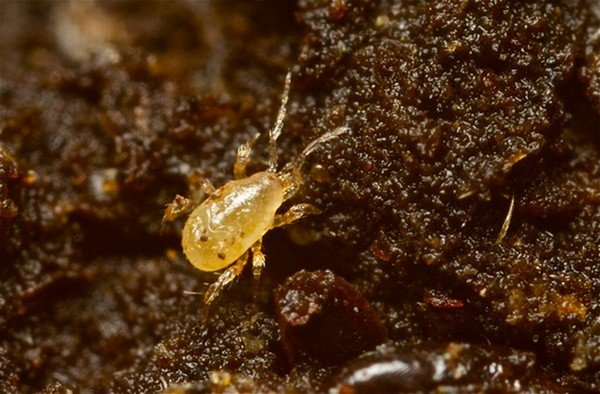
How dangerous is the soil mite for plants. What types of small mites are dangerous to plants and how to remove them to fight. Useful types of soil mites. Control measures, use of biological and chemical agents. The use of folk methods.
Science knows a huge number of species of ticks, there are those that are dangerous to animals, there are parasites that are dangerous for people, but there are also those that can harm plants. Pests that can harm include soil mites. This is a fairly common insect, under favorable conditions they multiply quickly and are very dangerous.
Description of the pest
The root soil mite is an amazing creature. It is in the soil all the time, but almost no one notices it. But if your bulbous plant dies, then it is worth shaking out the soil and carefully examining it. It is easy to recognize by its appearance. It is a light, translucent insect.
It is very hardy and does not die without food and moisture. Under unfavorable conditions, his metabolic processes only slow down. But under suitable conditions, they come to life again and begin to feed on roots and bulbs.
The soil mite has very strong jaws. Therefore, insects easily damage the tissue of the bulb. In the vacated space, they lay eggs. Gloxinia, hyacinths and orchids are most susceptible to infection.
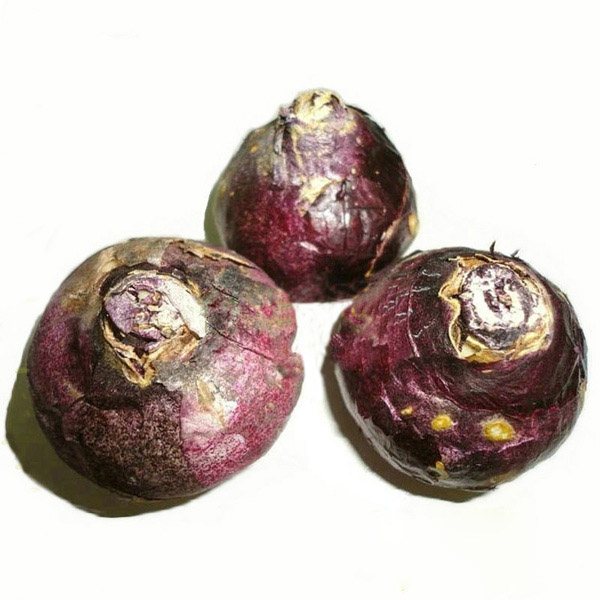

Types of mites that live in the soil
Ticks are the largest group of the arachnid class. Described 54 thousand species, most of which live in the upper layers of the soil. These animals are microscopic in size from 0.2 mm to 1 mm. Their body is whole, there are 6 pairs of appendages. The anterior pairs were transformed into oral organs - chelicerae and pedipalps. The other 4 pairs are legs.
By the nature of their diet, they are divided into several groups:
- saprophages - species that feed on organic residues of plant and animal origin;
- phytophages - arthropods that eat plant tissues;
- predators - mites that prey on small insects, invertebrates, nematodes, etc.
Carapace mites (Oribatida) are the dominant species among soil dwellers. There are 5 phases in their development. At the adult stage, they are resistant to various external influences due to the presence of a hard shell. Live and dead plants, mushrooms, lichens are used as food. There are no parasites among the mites.
Information. The number of Oribatida in the soil reaches 100 thousand individuals per 1 sq. m.
In addition to oribatids, hundreds of species of mites live in the soil, contributing to the processing of organic residues. Their vital activity is closely related to microflora. Soil mites eat bacteria, fungal spores, and algae. Their population increases in spring and autumn, when the land is abundantly moistened. During the dry summer season, the arthropod population decreases.
Predators are neighbors of saprophage mites. These individuals exceed the size of herbivorous relatives. Members of the Bdellidae family reach 3.5 mm. These are free-living individuals with a soft body and an outgrowth on the head in the form of an elongated nose. His diet includes small arthropods and insect larvae.
Signs of defeat
Soil mites in indoor flowers are not very common. In the garden, they can be found in beds with garlic or onions; they do not change their preferences in pots either.Plants are harmed not only by adult insects, but also by their larvae. How can you tell if a green pet needs help?
First of all, the leaves begin to change. They warp, some areas change color. Fresh soil that you calcined or treated with potassium permanganate before planting cannot be infected with a tick. Usually this is a problem with pots in which the soil has not changed for a long time. Therefore, do not forget about the rules of care.
If you have ever seen a bulb from which only one shell remains, then you will forever remember how the soil mite works. Damaged bulbs begin to mold and rot. The more time has passed since the bulb was chosen by insects, the stronger the damage. Gradually, it loses its elasticity. You can see passages and cavities in it. Gradually, only one shell remains of it. In it you can find larval skins and excrement. You can usually see insects at a wide variety of stages of development.
Houseplants
- Pests can appear in absolutely any soil, the main conditions for them are moisture and organic matter. There are a large number of factors for their development. When infected, the condition of the flower deteriorates significantly. Also, confirmation that the plant is infected is the presence of an unpleasant putrid odor that appears immediately after watering the flower.
- Some species, such as root mites, contribute to decay of orchids, gloxinia, violets. Usually they stay close to the surface, if the condition of the flowers has deteriorated for no apparent reason, then the source of the problem must be looked for in the ground. One of the signs of the activity of soil mites is the appearance of a putrid smell after watering.
- Since their size is very small, it will not be possible to examine the earth mite. But you can do the following, take a small amount of soil and look with an ordinary magnifying glass. In addition to pests, there are also those individuals in the flower pot that do not bring any harm to the plant, but, on the contrary, benefit, since they feed on mites, which are pests.
- For example, one such beneficial predator is the tick, which belongs to the Gamasoidea family. They have a small body size that does not exceed 1 mm. The color of the body is sandy, it can have a light brown color. The body is rounded and all covered with hairs. Most often they live closer to the surface and on the surface of the soil.
- You should not fight these ticks, on the contrary, they are irreplaceable helpers for the extermination of parasites. If there are no pests and microorganisms in the soil, they will disappear on their own.
Where does the problem come from
The ideal condition for the appearance of soil mites in indoor plants is warm and waterlogged soil. Therefore, if you tend to fill the pots, then the risk of ticks increases several times. Ticks quickly crawl from one pot to another. Therefore, infected plants must be destroyed or isolated from healthy ones. A good way out of this situation would be immediate treatment, as well as simultaneous prophylaxis among healthy plants. The easiest way to get a tick in your collection is to buy bulbs or a substrate that already contains the parasite in the store.
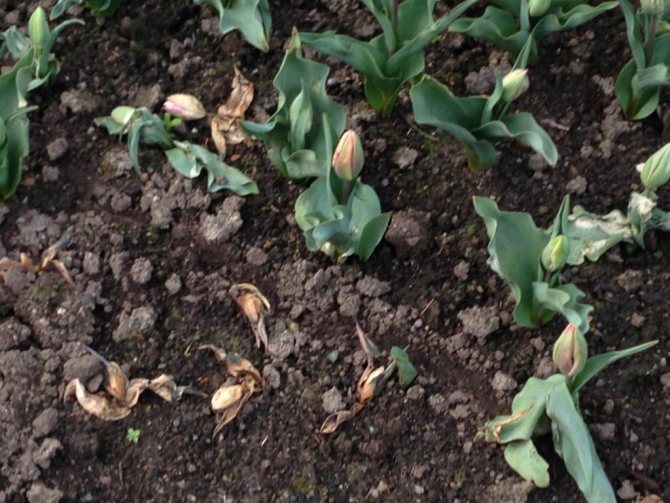

Rizoglyphuses
This mite is distributed all over the world, its diet consists of different types of food. It can feed on grape roots, onions, potatoes, cereals and ornamental flowers. The size of the pest reaches 0.8-1 mm, the body is elongated, light in color with a yellow tint. The legs are well developed, each limb has spines.
If the bulb is damaged, then the tick penetrates the middle through them, there is no accessible road, then it gnaws through it. In the middle of the bulb, it absorbs the juice, which is harmful. In areas where a warm and important climate is at risk, flowers planted in the open field. Threatened daffodils, gladioli, tulips, etc.Infected flowers cannot develop normally and their growth slows down, in addition, they are susceptible to infection with various diseases.
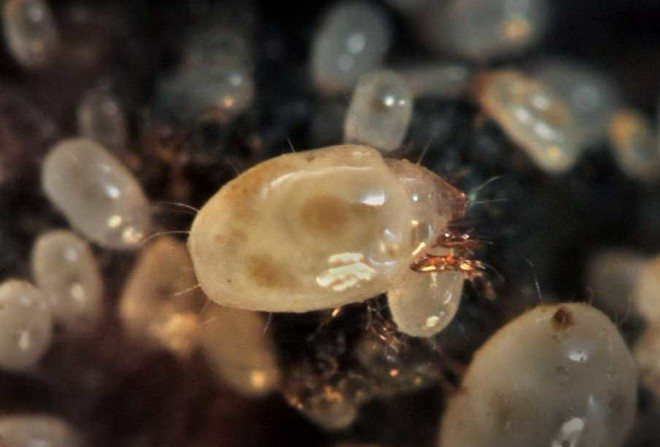

If these mites get on human skin, irritation and severe itching will begin. They are very fond of moisture, and at elevated temperatures, life processes and development are accelerated. The female lays up to 800 eggs, of which larvae appear in a week. The life cycle of an adult is 2 months.
Preventive actions
It is much more important to prevent a problem than to deal with it later. This also applies to soil mites. You can see a photo of this pest in our article. If you do not look for it on purpose, then you can easily miss the tiny insects in the ground. They usually settle where bulbous plants have been planted. And if a new hyacinth suddenly gets sick, it is worth digging up the bulb and carefully examining it.
But this is already to the question of the struggle. and what to do to prevent pests from damaging your green pets? Let's take a look at the basic rules.
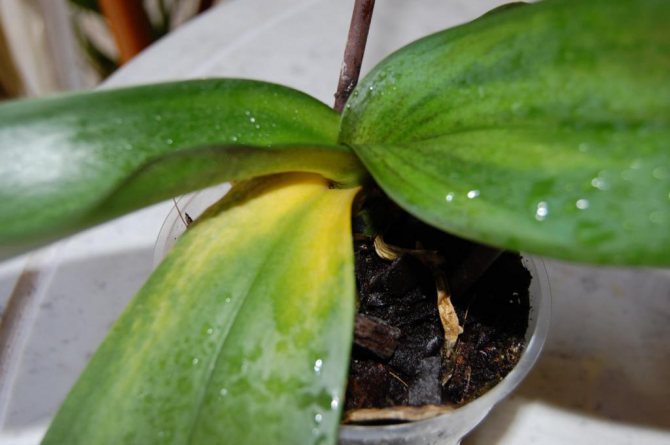

Tyrophagus
This species is no less dangerous and capable of causing significant damage. They live in the ground, but if the humidity is too high, they move to more comfortable conditions, namely to the leafy part. Most often, they take up young shoots. The signs by which you can determine the infection include drying of the bulb, the appearance of spots on it, punctures appear on the leaves, a brown bloom forms on the lower part of the leaves.
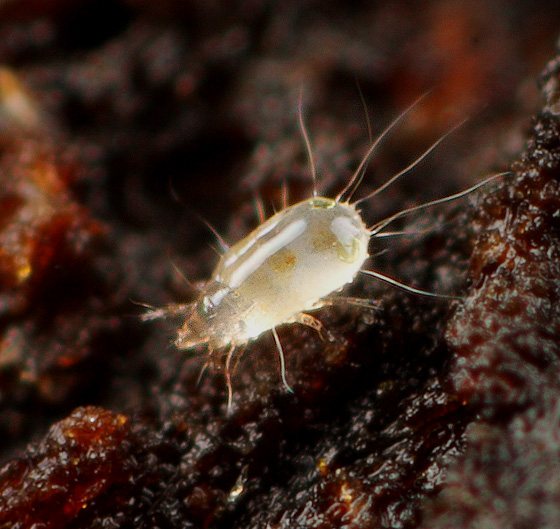

The fight against them is carried out by regulating the level of humidity, specialized means are used. In order to get rid of pests on the plant itself, it is treated with Fitoverm. To destroy it in the soil, it is sprinkled with a special powder, for example, Nissoran is used. It is very important to comply with the storage standards for planting material. Before sending it for storage, it must be warmed up and stored only in a dry place. If any damage is found, the material is removed.
Simple rules
- Refuse to buy if new plants are suspicious. When buying bulbs, move the scales apart a little. The parasites can be easily seen and the extent of the damage can be assessed. If the seller does not allow the bulbs to be inspected, it is best not to buy them.
- If you are using your own plant material, dry it after harvesting. Bulbs of tulip, hyacinth and other popular plants must be dried for 16 hours at a temperature of +40 degrees.
- Planted plants need to be watered with chamomile decoction with a temperature of +35 degrees. It will be fatal to parasites.
- Dry both the bulbs and the storage before storing the bulbs. The room must be pickled, and the bulbs must be treated with special substances against fungus and mites.
- Storage temperature and humidity should be reduced. The higher the indicators, the better the conditions for the development of insects. Check the seeds regularly so that you can take immediate action when the slightest sign of damage appears. It is best to remove the onion and set it apart. If you do not see ticks, then you can observe her condition. If it gets worse, it is best to burn the bulb.
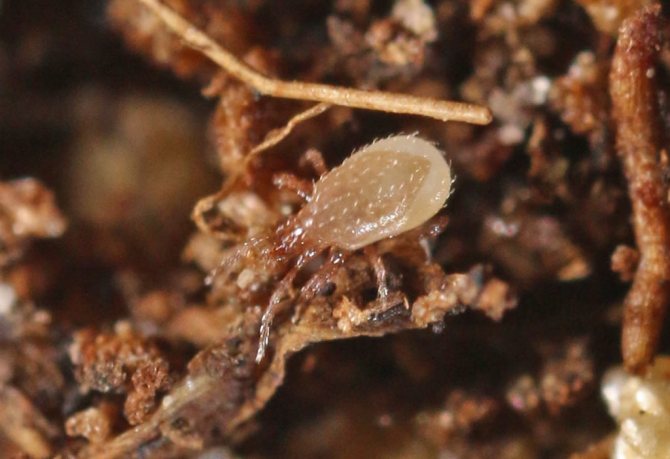

Root mite chemical attack
Root mites are resistant to pesticides. In order to prevent, before planting a home plant, its tubers (or bulbs) are dipped in an oil-soap solution: half a tablespoon of washing powder is well dissolved in hot water (200 ml). Add 0.5 tbsp to the soap solution. oil (machine). Bring the emulsion to 1 liter with water. The roots should be in the resulting warm mixture for about half an hour.


Neoron is a time-tested chemical, but the tick can get addicted to it
Neoron, Apollo, Actellic ... These insecticides will be effective if you alternate their application with each other. At the same time, it is better to spray Actellik on those flowers that are in non-residential premises. Acaricides are also effective: Clofentezin, Karbofos, Dimethoat-400, etc. Pesticides such as DI-68, Tagor, Danadim, ProRogor, Fostran and others are also used. During the period of vegetative growth of domestic plants, when a root mite is found, the fight should be carried out with a 0.2% solution of Rogor or Keltan. If damage is detected on the roots, bulbs, they must be kept in a solution of Acaricil or the plant should be watered. You can also disinfect in one of the solutions of systemic insecticides Neorona, Apollo.
Nothing pleases on winter days like a home flower on the window. To protect it from pests, you need to know how to deal with pathogens, to successfully apply knowledge in practice.
Check out articles on similar topics
- How to get rid of and means of combating scale insects on indoor plants
- How to deal with mealybugs on indoor plants
- Thrips on indoor plants: methods of control and treatment
- How to get rid of springtails and podura in indoor flowers
Comments (1)
- Svetlana
A cry for help. I bought several bulbs of hippeastrum of different varieties and from different sites and did not look until. All but one successfully bloomed and grow, and one seemed to have a missing growth point, did not wake up for a long time. I, so that not everything was in vain, tried to get children from her, and now I cry and do not know what to do. The onion mite populated all the pots and even the crops with children, in general, everywhere, and I have about a hundred plants and half of them are bulbous. Help, please, tell me how to be. Fitoverm, actellik and others like that do not help. I can't dry the plants either. The land has already changed and more than once. I ignite everything infected even before discarding at a temperature of 200-250 degrees. I also ignite the new purchased land, my bulbs, nothing helps.
21.06.2018
Reply
leave a comment
How to get rid of pests
If the lesion is minor, and you noticed it on time, then no problems with treatment should arise, especially if you know how to get rid of the soil mite.
- The easiest way is to use soapy water. They watered the earth and wiped the leaves with it.
- The second most popular, but not effective, is the infusion of garlic in water. Usually, the procedures are repeated until all symptoms of the disease disappear completely.
- For indoor plants, you can use an ultraviolet lamp. It is enough to keep it turned on for two minutes a couple of times a week, and all pests will completely disappear.
- Nettle also helps fight pests. To do this, take 0.7 kg of nettle and pour 5 liters of boiling water. Place the vessel in a warm place. After five days, strain, dilute 1:10 and water to the root.


Fighting uninvited flower pot residents
Soil mites are resistant to various adverse factors. When conditions worsen, they are able to enter a state of diapause, which is similar to suspended animation. If the substrate is seriously infected with mites, then it is better to replace it. It is recommended to disinfect the roots of plants before planting in new soil. For this, a decoction of tansy is prepared - 100 grams of dry grass is poured into 1 liter of boiling water and boiled for 15 minutes. After cooling, the bulbs or roots are dipped into the broth for half an hour.
One way to limit the number of mites is to reduce the moisture content. Watering stops for 7-10 days. It is also necessary to arrange a drainage layer at the bottom of the pot to control the amount of moisture.
Chemicals are a last resort in pest control, but sometimes they cannot be avoided. The following acaricidal preparations are used:
- Akarin is a means of biological origin that has an intestinal contact effect.
- Apollo is a concentrated suspension of contact action, the rate of use is 2 ml per 5 liters of water.
- Vertimek is a preparation of natural origin based on a mushroom.
- Kleschevit is an insectoacaricidal preparation for protecting decorative flowers in greenhouses. The biological agent leads to the death of ticks 3 days after application.
Soil mites help maintain the natural balance of microflora and contribute to the formation of humus. Only certain species of arthropods pose a danger to cultivated plants. To combat them, effective biological and chemical preparations have been developed.
With a strong defeat
And how to deal with a soil mite if the number of affected areas is already large? It is no longer possible to cope with folk remedies; more intensive measures of influence must be applied. Systemic insecticide treatment will help kill all parasites. Moreover, this remedy works for a long time, therefore it manages to destroy even the future generation. "Actellic" or "Neoron" are best suited. Do not forget that insects get used to the drugs used, and therefore they should be alternated. Usually, systemic insecticides can save the plant even in the most advanced cases. And only if the bulb began to rot due to a large amount of damage, it becomes impossible to save it.
Signs of a soil mite infestation
Under favorable circumstances for humans, field mites are located deep in the soil and do not appear on its surface. Only when they multiply rapidly and exceed the allowable amount for safety, parasites can be found on the soil surface. Typical signs of the presence of root mites in a plant are the following:
- white dust on the surface of the ground near the rhizome, and under it there are multiple small passages;
- desiccation, wrinkling and looseness of the bulbs;
- covering of roots and rhizomes with mold or spots of various sizes;
- looseness and softness of tubers, when they are taken out of the ground, they crumble or easily wrinkle;
- retardation of plant growth and deformation of the rudiments of peduncles;
- an unpleasant smell of the soil, reminiscent of a putrid environment;
- small holes and dark areas can be found on the leaves;
- in the soil mixture, you can dig out the shells from the larvae;
- brown scar tissue is visible on the underside of the leaves.
In general, when infected, the houseplant quickly withers and withers. The soil becomes dry and loose, and watering does not solve the problem of drying out and cracking of the top layer of the earth.
Important! For any of the above signs, you should isolate the diseased plant from other flowers to avoid contamination of healthy soils.
Remedies
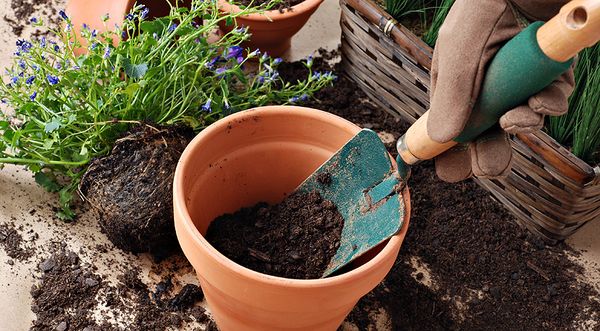

If mites have been found in the flower soil, then it is necessary to take measures to combat it, since these insects can destroy the plant. The following measures are considered the most effective ways to eliminate this pest:
- filtration and cleaning of the earth;
- transplanting a flower into a new disinfected pot;
- soaking the underground part of the plant in water. This method removes dirt and remnants of old soil on which larvae or adults can survive. After soaking the roots, the flower transplant is performed quickly so that the underground part does not have time to dry out. This is especially important for tropical representatives of the flora kingdom;
- use of insecticides containing pyrethrins. Processing is carried out simultaneously with watering. This is the most effective way;
Despite the fact that root mites do not cause obvious harm in the garden, they pose a serious danger to home flowers. Therefore, when they are identified in a pot, the above methods of elimination are performed.
Reasons for the appearance
As practice shows, the areas of inexperienced gardeners are most often affected.Ignoring the basic rules of plant care and crop rotation can lead to irreparable consequences.
- The strawberry plantation is characterized by high humidity and a large number of shaded areas.
- The grower is unable to ensure timely weed control.
- Exceeding the permissible density of stands.
- Lack of control over the spread of antennae.
All of the above conditions are ideal for the development of phytonemus pallidus. It should be noted that the yield of affected plantations is reduced by an average of 50%.
Often, the tick enters the site with the planting material, and then spreads through tools and work clothes.
The parasite is very fond of conditions of high humidity, and does not tolerate direct sunlight. That is why pests prefer to hide in young, not yet formed leaves.

